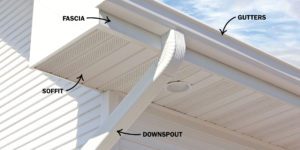Soffit and Fascia Have Two Purposes for Your Home:
1. Ventilation
Ventilating your attic is essential to prevent moisture and mold from growing in your attic’s insulation. Soffit acts as a passive ventilation unit for your attic—air from the soffit cycles to the vents drawing heat and moisture away from the house. Evenly venting to the roof prevents damp patches, and ultimately helps keep the roof from rotting. The gathering of this moisture is a breeding ground for mold. Mold can cause several problems, from roof rot to poor indoor air quality.
2. Protection
Soffit and fascia play crucial roles in your home’s defense system. First, they are a barrier from pests like bats, birds, ducks, raccoons, and squirrels. These pests can make your house their home by nesting in your attic, causing damage to your roof or electrical system. Next, they protect your home from intense weather like rain and wind. They also guard under the eaves, preventing outside objects like dirt, leaves, and snow from blowing into your roof.
What is Soffit?
The roof of your home often extends past its walls. The underside of this overhang, when given a finished appearance is known as a soffit, meaning “something fixed underneath.” The soffit is any finishing material installed to cover the underside of your roof’s overhang. Homes that do not have overhangs do not have soffit.
What is Fascia?
Fascia is material that’s installed on the lower end of the eave rafters or rafter tails and wraps under your shingles. The role of fascia is to form extended, horizontal support for the lower edge of the bottom row of your shingles. Fascia helps the rainwater flow directly into the gutters and away from your home. Think of fascia as trim around your roof, which protects the exposed ends of your rafters. Your gutters are anchored to this fascia material.
What are Eaves?
Eaves are at the ends or edges of the roof that overhang the exterior face of a wall and project over a building’s side. The main reason to build a structure with eaves is to divert rain and snow away from the building. Eaves can also be an architectural element enhancing the character and style of your home. The depth and size of eaves can vary significantly from home to home.



